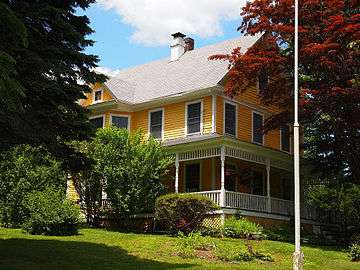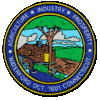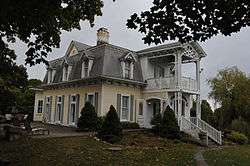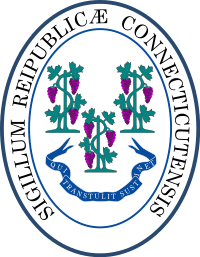Waterford, Connecticut
Waterford is a town in New London County, Connecticut, United States. It is named after Waterford, Ireland. The population was 19,517 at the 2010 census. [2] The town center is listed as a census-designated place (CDP) and had a population of 2,887 at the 2010 census.[2]
Waterford, Connecticut | |
|---|---|
 A house in Quaker Hill | |
 Seal | |
Location in New London County, Connecticut | |
| Coordinates: 41°20′59″N 72°08′49″W | |
| Country | United States |
| State | Connecticut |
| County | New London |
| Metropolitan area | New London |
| Incorporated | 1801 |
| Government | |
| • Type | Representative town meeting |
| • First Selectman | Robert J. Brule (R)[1] |
| • Selectwoman | Jody Nazarchyk (R) |
| • Selectwoman | Elizabeth A. Sabelia (D) |
| • Town Clerk | David L. Campo (R) |
| Area | |
| • Total | 44.6 sq mi (115.4 km2) |
| • Land | 32.8 sq mi (84.9 km2) |
| • Water | 11.8 sq mi (30.5 km2) |
| Elevation | 46 ft (14 m) |
| Population (2010) | |
| • Total | 19,517 |
| • Density | 440/sq mi (170/km2) |
| Time zone | UTC−5 (Eastern) |
| • Summer (DST) | UTC−4 (Eastern) |
| ZIP code | 06375, 06385 |
| Area code(s) | 860 |
| FIPS code | 09-80280 |
| GNIS feature ID | 0213526 |
| Website | www |
Geography
According to the United States Census Bureau, the town has a total area of 44.6 square miles (115.4 km2), of which 32.8 square miles (84.9 km2) is land and 11.8 square miles (30.5 km2), or 26.43%, is water.[3] The town center CDP has a total area of 1.9 square miles (4.9 km2), all land. Waterford is bordered on the west by the Niantic River.
Principal communities
- Graniteville
- Jordan
- Millstone
- Morningside Park
- Quaker Hill (06375)
- Bartlett Point, Best View, Cohanzie, Thames View
Other minor communities and geographic features are Dufree Hill, East Neck, Fog Plain, Gilead, Goshen, Great Neck, Harrisons, Lake's Pond, Logger Hill, Mago Point, Magonk, Mullen Hill, Oswegatchie, Pepperbox Road, Pleasure Beach, Ridgewood Park, Riverside Beach, Spithead, Strand, West Neck.
History
Founding
The first people emigrated from England in 1637, and came to the New London and Waterford area (at the time, this land was called West Farms). One of the first people who set sail for this area was John Winthrop, Jr. Waterford got its name for its proximity to being in between two rivers. The residents of Waterford resided in wigwams until they dug up plots for 38 houses near the Great Neck area. John Winthrop was given several hundred acres of land, including Millstone Point and Alewife Cove. Various dams, mills, and ponds were constructed in these area. The only expansion of people in the Waterford-New London area were the growth of families and children. Later on, more people immigrated to Waterford, including the Welsh, Italian, Russian, Irish, and Scottish.
Waterford finally disbanded from New London on October 8, 1801. This happened after several farmers decided to hold a petition to separate them. The first town meeting was held in November, 1801 to appoint town officials; tax collectors, town surveyors, Fence Viewers, and First Selectman. Only the first selectman got paid at the time.[4]
19th century
Waterford in the 19th century was a huge agricultural town, having mostly sheep farms. Waterford was also widely known for its granite industry that lasted from the late 19th century to the 1930s. Graniteville, a district in Waterford, is named after this industry. Although not part of Graniteville, the area today known as Crystal Mall was also home to granite quarries. Waterford's granite was used in many construction projects such as roads, the foundation for Fort Sumter, and the Statue of Liberty. Granite though was replaced by concrete which slowly shrunk the granite industry until the 1930s.[5]
20th century
During the 20th century, sheep farms were replaced by dairy farms. Between 1920 and 1960, there were about 100 dairy farms in Waterford. In addition, there were 10 to 100 heads of cattle. Waterford also obtained its town seal in 1946. It was made by Martin Branner who was a cartoonist who also made the famous comic, Winnie Winkle. After World War II, Waterford boomed with development. Many new roads and building were made. Also, Waterford's population increased by 10,000 between 1946 and the present time. In 1957, the first stop light was added in Waterford. In addition, the first retail center was built in 1978.
Demographics
| Historical population | |||
|---|---|---|---|
| Census | Pop. | %± | |
| 1820 | 2,239 | — | |
| 1850 | 2,259 | — | |
| 1860 | 2,555 | 13.1% | |
| 1870 | 2,482 | −2.9% | |
| 1880 | 2,701 | 8.8% | |
| 1890 | 2,661 | −1.5% | |
| 1900 | 2,904 | 9.1% | |
| 1910 | 3,097 | 6.6% | |
| 1920 | 3,935 | 27.1% | |
| 1930 | 4,742 | 20.5% | |
| 1940 | 6,594 | 39.1% | |
| 1950 | 9,100 | 38.0% | |
| 1960 | 15,391 | 69.1% | |
| 1970 | 17,227 | 11.9% | |
| 1980 | 17,843 | 3.6% | |
| 1990 | 17,930 | 0.5% | |
| 2000 | 19,152 | 6.8% | |
| 2010 | 19,517 | 1.9% | |
| Est. 2014 | 19,427 | [6] | −0.5% |
| U.S. Decennial Census[7] | |||
The town consists of a wide variety of rural and city living. At the 2010 census, there were 19,517 people in 8,005 households, including 5,335 families, in the town.[2]
The population density was 584.7 people per square mile (225.8/km2). There were 7,986 housing units at an average density of 243.8 per square mile (94.2/km2).
The racial makeup of the town was 89.4% White, 2.5% African American, 0.5% Native American, 3.7% Asian, 0.1% Pacific Islander, 1.3% from other races, and 2.5% from two or more races. Hispanic or Latino of any race were 4.7% of the population.[2]
There were 8,005 households, 26.4% had children under the age of 18 living with them, 53.0% were married couples living together, 9.2% had a female householder with no husband present, and 33.4% were non-families. 28.0% of households were made up of individuals, and 9.8% were one person aged 65 or older. The average household size was 2.38, and the average family size was 2.91.[2]
The age distribution was 22.9% under the age of 20, 3.9% from 20 to 24, 21.3% from 25 to 44, 31.9% from 45 to 64, and 20.1% 65 or older. The median age was 46.1 years.[2]
The median household income was $73,156 and the median family income was $93,933. The per capita income for the town was $114,645. About 3.1% of families and 5.4% of the population were below the poverty line, including 3.9% of those under age 18 and 6.9% of those age 65 or over.[8]
Town center
At the 2010 census,[9] there were 2,887 people in 1,327 households, including 732 families, in the town center CDP.
The population density was 1,465.7 inhabitants per square mile (566.6/km2). There were 1,379 housing units at an average density of 688.6 per square mile (266.2/km2).
The racial makeup of the CDP was 87.8% White, 4.3% African American, 0.8% Native American, 2.9% Asian, 0.8% from other races, and 2.3% from two or more races. Hispanic or Latino of any race were 6.5% of the population.[9]
There were 1,327 households, 20.4% had children under the age of 18 living with them, 39.5% were married couples living together, 11.5% had a female householder with no husband present, and 44.8% were non-families. 39.0% of households were made up of individuals, and 18.4% were one person aged 65 or older. The average household size was 2.11 and the average family size was 2.80.[9]
The age distribution was 19.2% under the age of 20, 5.0% from 20 to 24, 4.1% from 25 to 44, 23.8% from 45 to 64, and 23.9% 65 or older. The median age was 46.7 years.[9]
The median household income was $59,886 and the median family income was $69,543. The per capita income for the CDP was $71,509. About 4.6% of families and 7.7% of the population were below the poverty line, including 4.2% of those under age 18 and 20.4% of those age 65 or over.[8]
Education
Elementary schools appeared in 1915 when Quaker Hill School was built. Earlier, a lot was set aside for Quaker Hill in 1725 while the town was split into three districts: "Neck and Nehantick quarters," "West," and the "North East." Each district would end up getting split into even more individual districts. Later on, a second schoolhouse was replaced, built in 1858. Cohanzie School was built in 1923. It replaced four schools: Gilead School, "Peter Baker" located on far northern Vauxhall Street, Lakes Pond brick building, and Cohanzie predecessor.[10][11]
Jordan Schoolhouse
1737 is the earliest mention of a schoolhouse in Waterford, known as the Jordan Schoolhouse, located on the Jordan Green. Farmers mainly wanted their children to be taught writing, reading, arithmetic, and religion. The Jordan School also influenced proper manners and obedience. Private lessons were of no need in Waterford, but were set up in the 19th century for those who had enough money to afford it. The Jordan School's last day of teaching was in the year 1979 with a final assembly. The Jordan School is still used but is held as a museum to the public.[12][13]
Government
Town Meeting

Waterford's local government is structured using a representative town meeting system. There are four elective districts in town, and each one sends one representative to the town meeting per every 550 electors in that area. As of 2017, districts 1 and 2 have 5 representatives, and district 3 and 4 have six, giving the Town Meeting a total of 22 elected members. In 2017, six Democrats, four Greens, and twelve Republicans were elected to the body.
As of the 2017 election results,[14] the Representatives of the Waterford Town Meeting are:
| District | Name | Party |
|---|---|---|
| 1st | Robert Swansen | REP |
| 1st | Timothy Condon | REP |
| 1st | Valerie Muckle Metivier | REP |
| 1st | Danielle Steward-Gelinas | REP |
| 1st | Nick Gauthier | DEM |
| 2nd | Baird Welch-Collins | DEM |
| 2nd | Greg Attanasio | DEM |
| 2nd | Margaret Welch | DEM |
| 2nd | Ted Olynciw | DEM |
| 2nd | April Cairns | REP |
| 3rd | Liam O'Leary | REP |
| 3rd | David Lersch | REP |
| 3rd | Jennifer Antonino Bracciale | REP |
| 3rd | Paul Goldstein | REP |
| 3rd | Richard Morgan | REP |
| 3rd | Richard Muckle | REP |
| 3rd | Kathy Kohl | DEM |
| 3rd | Tim Fioravanti | DEM |
| 4th | Susan Driscoll | DEM |
| 4th | Sally Ritchie | DEM |
| 4th | Steve Elci | DEM |
| 4th | Mike Bono | REP |
| 4th | Michael Rocchetti | REP |
| 4th | Thomas Dembek | REP |
Economy
Waterford's economic center is predominantly retail chains, including a variety of mini-malls and the Crystal Mall.[15] There are several family-owned delicatessens and restaurants. Waterford is also home to JayPro Sports, which manufactures sports equipment for baseball, basketball, and tennis,[16] and to Dominion's Millstone Nuclear Power Plant. The plant consists of three reactors, the first built between 1966 and 1970. While Millstone's first reactor is no longer in operation, the remaining two still provide power to a variety of towns in New England.
Attractions


- Mago Point, Waterford, Connecticut is an area in Waterford that is home to many marine businesses such as The Dock Restaurant, the Sunbeam Fleet, Mago Point Marina, Hillyers Bait and Tackle, the Mijoy 747 fishing boat, Sunset Ribs, Mago Point Packy, and the Niantic Bay Boat Valet[17] It is a large tourist site, attracting people from all around the North East to Waterford.
- The Connecticut College Arboretum is a 750-acre (3.0 km2) arboretum and botanical garden which lies partially within Quaker Hill, a neighborhood of Waterford.
- The Eugene O'Neill Theater Center is located in Waterford, as is the Intentional Theatre.
- Waterford Beach
- Harkness Memorial State Park is a recreational area that provides a picturesque view of Long Island Sound. The park features the former mansion, gardens and grounds of Edward Harkness, who bought the property in 1907. Activities include fishing, formal gardening, golf, and tours of the mansion, known as Eolia. The Harkness estate is also open for formal occasions including weddings, and is often used for group photography.
- Adjacent to the Harkness Memorial State Park is Camp Harkness for the Handicapped, a summer facility for children and adults with physical and/or mental disabilities. Most of what is now Camp Harkness for the Handicapped was once a golf course, but there is no longer a trace of this golf course in evidence.
- The Waterford Speedbowl is a racetrack recognized under NASCAR's Whelen All-American Series sanction. It holds touring events throughout the year, including the NASCAR Whelen Modified Tour, Valenti Modified Racing Series, International Super Modified Association and North Eastern Midget Association among many others. The track holds weekly NASCAR events every Saturday from April thru mid-October. The popular Wild N' Wacky Wednesday series runs from May to Labor Day. Recently they have added Friday Night Sho N' Go drag races during the summer.[18]
- In 2009, Waterford was the home of the game show Deal or No Deal, which was filmed at Sonalyst Studios.
- The Seaside Sanatorium continues to be considered prime real estate in Waterford, Connecticut, being a 36-acre (0.15 km2) shoreline property, located on the original parcel of 11 Magonk Pt. The property was designed by the renowned architect, Cass Gilbert. The Sanatorium opened in 1934 to treat patients suffering from tuberculosis by using heliotherapy, until 1958 when patients relocated to Uncas on the Thames and it later became a Geriatric Hospital, which opened in 1959-1961. Later in 1961, the Sanatorium opened to serve people with Developmental Disabilities, staying open until 1996.[19][20][21]
Emergency services
Police department
The Waterford Police Department has 47 officers on active duty. "The Waterford Police Department, commanded by Chief Brett Mahoney, also has a Board of Police Commissioners. The rest of the department consists of Lieutenants, Sergeants, Patrol Officers, K-9 Officers, Detectives, Traffic Officer, Evidence/Court Officer, School Resource Officers and civilian Community Service Officers."[22]
Crime
According to 2012 statistics, the crime rate in Waterford is below average compared to most cities in the United States.[23]
Statistics
The murder rate for Waterford is 5.1 per 100,000 with one murder occurring in 2012.[23] 6 robberies occurred as well as 38 assaults.[23] In 2012, 55 burglaries, 451 thefts and 9 auto thefts occurred.[23]
Fire service
The Town of Waterford is protected by a combination volunteer and career fire service, consisting of five fire companies located throughout the town.
Ambulance service
Ambulance service for the town is provided by Waterford Ambulance. The Waterford Ambulance Service (WAS) is a non-profit ambulance service dedicated to providing high quality emergency medical care to the residents and visitors of the Town of Waterford, Connecticut and surrounding communities with emergency medical services and ambulance transportation in accordance with established Federal and State laws and regulations.[24]
References
- "Elected Officials". Waterford CT. Retrieved 16 September 2015.
- "Profile of General Population and Housing Characteristics: 2010 Demographic Profile Data (DP-1): Waterford town, New London County, Connecticut". United States Census Bureau. Retrieved October 29, 2012.
- "Geographic Identifiers: 2010 Demographic Profile Data (G001): Waterford town, New London County, Connecticut". United States Census Bureau. Retrieved October 29, 2012.
- Bachman, Robert (2000). An Illustrated History of the Town of Waterford Connecticut. Waterford, Connecticut: Bicentennial Committee.
- Bachman, Robert L. (2000). An Illustrated History of the Town of Waterford Connecticut. Bicentennial Committee, Town of Waterford. p. 92.
- "Annual Estimates of the Resident Population for Incorporated Places: April 1, 2010 to July 1, 2014". Retrieved June 4, 2015.
- "Census of Population and Housing". Census.gov. Retrieved June 4, 2015.
- "DP03 SELECTED ECONOMIC CHARACTERISTICS 2009-2013 American Community Survey 5-Year Estimates". United States Census Bureau. Retrieved 8 March 2015.
- "Profile of General Population and Housing Characteristics: 2010 more information 2010 Demographic Profile Data". United States Census Bureau. Retrieved 8 March 2015.
- Bachman, Robert L. (2000) [1967]. An Illustrated History of Waterford Connecticut.
- Bachman, Robert L. (1977). TOEING THE MARK In A Colonial Waterford School. Waterford, Connecticut.
- Bachman, Robert (1975). Waterford And Independence 1776-1976. Town of Waterford: American Revolution Bicentennial Committee.
- Bachman, Robert (2000) [1967]. An Illustrated History Of Waterford Connecticut.
- "Waterford Election 2017 Results: Winners Revealed In Key Races". Patch Media. Retrieved 20 November 2017.
- Emil Pocock (February 23, 2009). "Largest Connecticut Shopping Centers". Shopping Center Studies. Eastern Connecticut State University. Archived from the original on September 27, 2011. Retrieved July 17, 2018.
- Moser, Erica (July 14, 2018). "Local manufacturers feel the pain of aluminum, steel tariffs". The Day. Retrieved 2018-07-17.
- "Mago Point Park". D.E.E.P. Retrieved 10 June 2013.
- "History of the Track". Archived from the original on 2006-08-19. Retrieved 2006-11-07.
- Michalski, Kim (5 Sep 1995). "Seaside's history, architecture recognized". The Day. Retrieved 9 June 2013.
- "Big State Sanatorium Project to be Located in Waterford". The Day. 4 Aug 1931. Retrieved 9 June 2013.
- "Vet promising plan for Seaside funding". The Day. 18 May 2013. Retrieved 9 June 2013.
- "Waterford Police Department, Waterford, CT". Waterford Police Department. Retrieved 12 August 2013.
- "Crime rate in Waterford, Connecticut (CT): murders, rapes, robberies, assaults, burglaries, thefts, auto thefts, arson, law enforcement employees, police officers, crime map". city-data.com. Retrieved 8 March 2015.
- "Waterford Ambulance Service | Timely and Clinically Excellent Service". waterfordambulance.org. Retrieved 2019-09-24.
External links
| Wikimedia Commons has media related to Waterford, Connecticut. |

